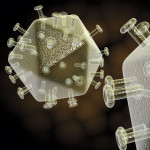 ViiV Healthcare’s experimental integrase inhibitor "compares favorably” with efavirenz (found in Sustiva and Atripla), particularly at the selected 50 milligram (mg) dose, with fewer treatment discontinuations due to side effects, according to 96-week follow-up data from the company’s SPRING-1 clinical trial reported Wednesday, March 7, at the 19th Conference on Retroviruses and Opportunistic Infections in Seattle.
ViiV Healthcare’s experimental integrase inhibitor "compares favorably” with efavirenz (found in Sustiva and Atripla), particularly at the selected 50 milligram (mg) dose, with fewer treatment discontinuations due to side effects, according to 96-week follow-up data from the company’s SPRING-1 clinical trial reported Wednesday, March 7, at the 19th Conference on Retroviruses and Opportunistic Infections in Seattle.
Dolutegravir is a second-generation integrase inhibitor that is active against HIV strains resistant to first-generation inhibitors Isentress (raltegravir) and elvitegravir. Dolutegravir can be taken once daily, without the need for blood-level boosting, and so far it appears to have minimal side effects. What’s more, the daily dose is small enough that it should be easy to combine with other drugs into a single pill—a prospect that is currently being explored in the form of 572-Trii.
To determine dolutegravir’s efficacy in people who hadn’t taken ARV therapy before, Hans-Jürgen Stellbrink, MD, of the Infektionsmedizinisches Centrum in Hamburg and his colleagues randomized 205 people to take Sustiva plus either Truvada (tenofovir plus emtricitabine) or Epzicom (abacavir plus lamivudine), or Truvada/Epzicom plus one of three potential doses of dolutegravir: 10 mg, 25 mg or 50 mg.
The participants in the study were mostly white males, their average age was about 37, and their average CD4 count was 324. Roughly 44 percent had viral loads above 100,000 copies upon entering the study.
During the first three months of the study, all doses of dolutegravir reduced viral loads to levels below 50 copies—undetectable—more effectively than Sustiva, which isn’t uncommon among integrase inhibitors.
After 96 weeks of treatment, undetectable viral load rates in the four groups were comparable. The percentage of people with viral loads less than 50 copies at 48 weeks was 79 percent with the 10 mg dose, 78 percent with the 25 mg dose and 88 percent with the 50 mg dose. Among those receiving Sustiva, 72 percent had viral loads below 50 copies after 96 weeks.
Significant increases in CD4 counts were reported in all study groups through 96 weeks of treatment.
About 8 percent, or 13 of the 155 patients receiving dolutegravir, experienced virologic failure during the 96-week follow-up period, compared with 8 percent, or 4 of 50 patients, in the Sustiva group. Seven failures occurred in the 10 mg dolutegravir group, four occurred in the 25 mg group, and two (4 percent) occurred in the 50 mg group.
No HIV mutations known to confer resistance to integrase inhibitors were documented in any of the patients who experienced virologic failure; only in one patient was there a reported mutation associated with resistance to emtricitabine and lamivudine.
About 24 percent of volunteers receiving Sustiva, compared with 11 percent of those receiving dolutegravir, experienced moderate-to-severe side effects in the study. Psychiatric problems and skin rash appeared to be more common among those taking Sustiva.
Side effects leading to withdrawal from the study or a change in ARV therapy occurred in 10 percent of those in the Sustiva group, compared with 3 percent of those in the combined dolutegravir groups.
Mild-to-moderate liver enzyme (ALT) increases were documented in 12 percent of patients in the Sustiva group, compared with roughly 4 percent of patients in the combined dolutegravir groups.
Small changes in serum creatinine—a component of muscle and an indicator of kidney function—were reported among those taking dolutegravir. It was seen in patients receiving both Truvada and Epzicom, thus was not believed to be related to tenofovir use. Stellbrink noted, however, that creatinine levels did not increase over time, nor did dolutegravir have a negligible effect on gold-standard testing for kidney function: glomerular filtrations rates (GFRs). He also said that dolutegravir-treated patients were no more likely to have protein detected in their urine samples after 96 weeks.
“In conclusion,” Stellbrink reported, “dolutegravir administered once-daily with two [nucleoside reverse transcriptase inhibitors] was associated with good treatment responses at all doses, with the selected 50 mg dose comparing favorably with efavirenz through 96 weeks.” He added that no integrase inhibitor mutations have been detected through 96 weeks and “fewer subjects treated with dolutegravir discontinued therapy due to adverse events when compared with efavirenz.
“Data through 96 weeks continue to support 50 mg once daily for integrase inhibitor-naïve subjects, and provide evidence for durable efficacy and tolerability for dolutegravir in combination therapy.”
Advertisement
Advertisement
Advertisement






1 Comment
1 Comment